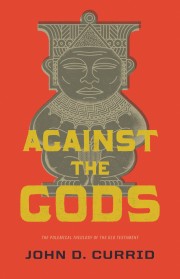About the Author
John D. Currid (PhD, University of Chicago) is the Carl McMurray Professor of Old Testament at Reformed Theological Seminary in Charlotte, North Carolina. He lectures worldwide and is senior minister at Ballantyne Presbyterian Church (ARP). Currid is the author of several books and Old Testament commentaries and has extensive archaeological field experience from projects throughout Israel and Tunisia.
Overview
Currid explores the explanatory power of “polemical theology” to understand the many and extensive parallels found in both thought and form between the Hebrew Scriptures and its historical setting in the Ancient Near East (ANE). Polemical theology suggests that the authors of Scripture intentionally borrowed or re-used pagan ideas and forms as a way of taunting and criticizing their polytheistic worldview. Currid first defines his key idea, summarizes the history of ANE studies, and then plunges in successive chapters into examples spanning mostly the Pentateuch.
Table of Contents
Prologue
1 A Brief History of the Ancient Near East
2 The Nature of Polemical Thought and Writing
3 Genesis 1 and Other Ancient Near Eastern Creation Accounts
4 Ancient Near Eastern Flood Accounts and the Noahic Deluge of Genesis 6-9
5 Joseph, the Tale of two brothers, and the “Spurned Seductress” Motif
6 The Birth of the Deliverer
7 The Flights of Sinuhe and Moses
8 Who Is “I Am that I Am”? Exodus 3 and the Egyptian Book of the Heavenly Cow
9 The Rod of Moses
10 The Parting of the Waters of the Red Sea
11 Canaanite Motifs
General Index
Scripture Index
Summary
Chapter 1. A Brief History of the Ancient Near East
ANE studies is a relatively recent development (only 200 years old) and is currently a booming area of research as archaeological discoveries continue to be made.
The Beginnings of Research in the Ancient near East (1798-1872)
The first major discoveries and rigorous analysis of ANE cultures began during Napoleon’s invasion of Egypt in 1798. It was the first time Europeans had the opportunity to study the ancient ruins of any ANE culture. Two major discoveries were made: 1) the valley of the Kings, and 2) the Rosetta Stone which allowed scholars to de-code Egyptian hieroglyphics. In the first half of the 19th century, work began in Mesopotamia. Several discoveries confirmed …
[To continue reading this summary, please see below....]
The remainder of this article is premium content. Become a member to continue reading.
Already have an account? Sign In
